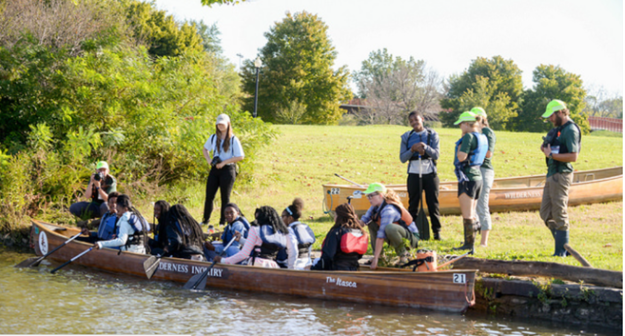Boating Across the Anacostia River
Story by Dayanna Shackleford. Photos by Braylon Wims.
APRIL 20, 2018: On March 22, 2018, Woodridge’s 8th graders enjoyed an entire day out of school to visit the Anacostia Watershed in Southeast Washington, DC. This was a great field trip before heading off for a week-long springbreak. Ms. Beckwith, Woodridge’s 7th and 8th grade science teacher, wanted us to have a real-world experience with science while learning about the watershed community and the impact that people have on the natural world. The goal of the Anacostia River Watershed program is to stimulate interest in the environment and provide education specifically about the Anacostia River.
The field trip allowed us to learn about the Anacostia River’s history and ecology. I ride across the river each day to school on the bus and on the weekends with my mom. But, I never thought about the people who work to keep the river clean and all of its history. This day of learning taught us about team building skills, critical thinking, and scientific investigation.
To start the outdoor hands-on investigative learning, we had to paddle for about 45 minutes going far out into river. This is absolutely fun! Some of my classmates were screaming because they were frightened by being so far out from the bank. I realized when we were paddling back and forth that we were using kinetic energy because we were in motion, and moving the paddle. From applying balanced and unbalanced forces in the canoe to determining kinetic and potential energy, we were able to use what we learned in science class in the real world.
After we came back, we made a big group circle, which included all of the groups, and talked about what we experienced and if we enjoyed it. After we finished our discussion in our group circle, we then separated back off into our three groups. This time we went to the stations. In the first station, we were inside where we learned about the different aquatic animals that were in the Anacostia River by viewing the different aquatic animals that were taken out of the water. Some were healthy and some were not as healthy, or on the verge of dying. We also learned about the biggest animals and aquatic animals the Anacostia workers had found. Some were very unique, including a turtle with one eye, a huge snapping turtle, and a fish with a lot of pesticides on it.
The next station we visited us how one thing can affect another and how floods can occur. We also learned how the chemicals we use can turn into polluted water when it rains because it all goes to our rivers and oceans. The chemicals that can cause polluted water are chemicals that we put on our plants so that flies do not eat their plants. And, water is polluted by fertilizer that farmers put on their crops and by the litter that we drop daily on the ground. All of the chemicals and trash mix together to make the water polluted.
In the last station, we learned about animals’ fur and how important it is to their bodies. For example, some animals’ fur is thicker than others because they live in colder climates, so they need more fur for more warmth. The fur of animals who lives in warmer climates is thinner because temperature is warmer.
Finally, we learned about deer antlers. One important fact is that a deer loses its antlers every year and grows more. Another fact that we learned is that each point on an antler counts for how many years they have been living.
Dayanna Shackleford is an 8th grade scholar and Braylon Wims is a 6th grade scholar at Friendship Woodridge Academy.




